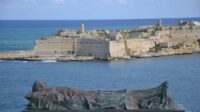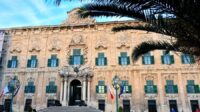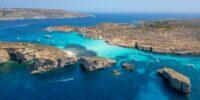We are head-over-heels in love with Malta’s capital city and its history. Let us share the story of the Knights Hospitalliers and how Valletta came to be the city we love and admire.
The monument to Grand Master de Valette, a stone’s-throw away from Parliament was only erected a few years ago. That is because for years the whole city was considered a living monument for la Valette, who had the vision to establish the place. It does carry his name after all. The Order of the Knights of St John had just successfully defended the island from an impending invasion by the Ottoman Empire during the Great Siege of 1565. The need for a new modern city facing the sea was all the more real.
In fact, on 28th March 1566, merely months after one of the bloodiest battles in Maltese history, Grand Master de Valette laid the first stone of the city. It would be described as ‘A city built by gentlemen for gentlemen.’

Punching way above her weight
Understandably, Valletta is the smallest capital city in Europe. However, don’t let its mere 1.6kms from one tip to the other deceive you. The peninsula is packed with so many layers of history and culture. Its streets have something for everyone to discover.
To truly appreciate the role Valletta had over the years, one needs to see the whole country as a city. And Valletta would be the historical centre. That is how everything started in Valletta, many years ago. For a long time, the city was the concentration of power and influence for the whole nation.
A beautiful gem of a city
The Knights spared no expense when designing the city. In fact, they brought over the best architects and civil engineers their Europe-wide contacts could obtain. The revolutionary grid-like layout of the city screams Renaissance. Valletta became one of the first entirely designed and planned cities in the world.
Then, they wanted their new home to be as beautiful and opulent as their counterpart cities on the mainland. So, they built impressive palaces to house their Auberges, one for each langue they represented. Today we would call them embassies. Then they built magnificent churches, decorated by the best decorators, artists and sculptures their deep pockets could pay for. They also made sure Valletta catered for their entertainment. They dotted it with gardens and piazzas that provided a breath of fresh air.

The Knights’ pièce de résistance
But their crowning jewel was the Co-Cathedral which rose proudly in the centre of the city. Dedicated to St John the Baptist, the Order’s patron, this outstanding edifice is a celebration of everything the Knights stood for. Looking at it from the outside, its Mannerist style is deceivingly simple – built at a time when a great deal of emphasis was on defence.
Very little you can read here will ever prepare you for what you will feel when you enter that front door. Every inch of the building is sculpted, gilded, and decorated with the finest art imaginable. Over here, you will meet a long list of masters who had the privilege to work in this, Malta’s most important church. From Mattia Preti, to Domenico Guidi, to the incredible Michelangelo Merisi better known as Caravaggio, whose most significant masterpiece from his prolific career is housed here – the Beheading of St John.
Out with the Knights, brief stint for the French, and in with the Brits
With a change of the guard during the Napoleonic era, the British took over the islands in 1800 and Valletta was once again at the centre of the country’s political and social development. The remnants of this period in history are all but vibrant mementos of a time when Valletta was a pivotal point in the world’s largest navy’s routes. Stories of drunken sailors, and colourful nights of merriment come to life with every cobbled alleyway of Valletta.
Valletta isn’t just history and art. It is a vibrant city offering something special for everyone’s tastes. The culinary scene in Valletta is varied and guaranteed to provide a tasty treat, no matter what you are after. From Michelin starred restaurants to quick and easy eateries, Valletta has any of your cravings sorted.
So, make sure to dedicate a good day – even more if you’re lucky enough to afford it – to visit the capital. This place will stay with you for a very long time, we promise it!















